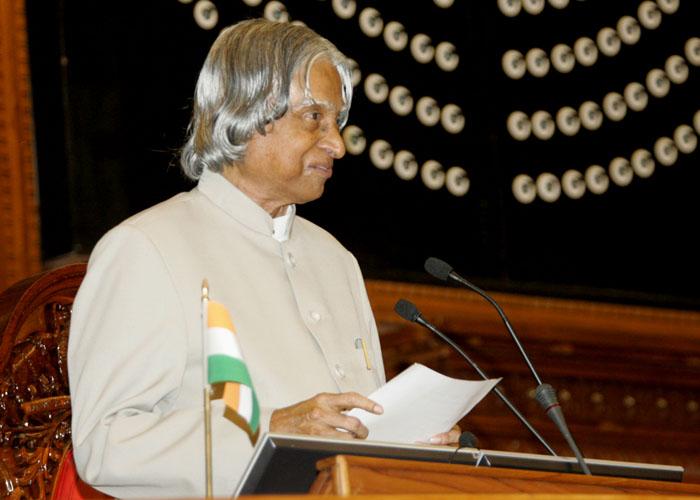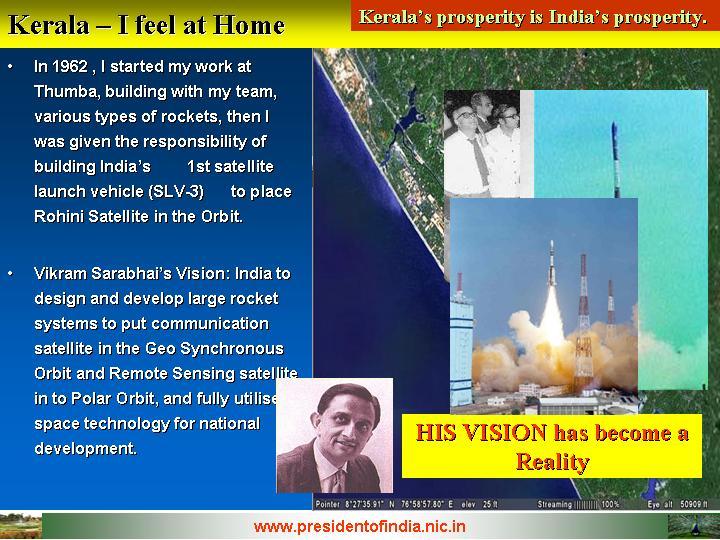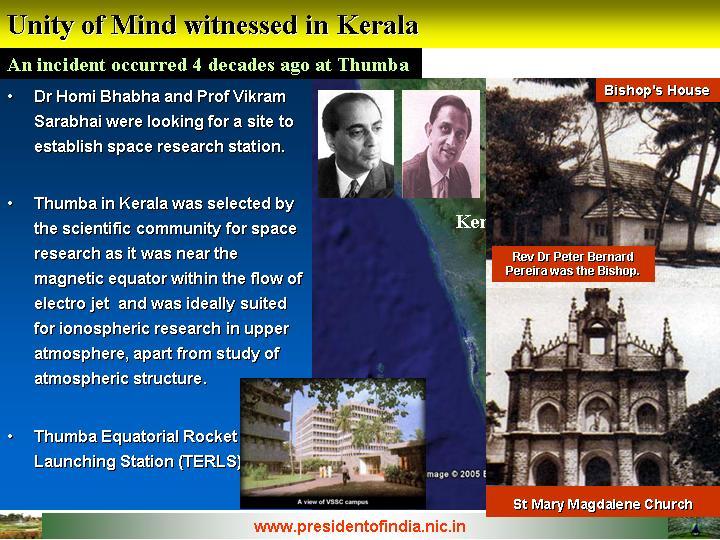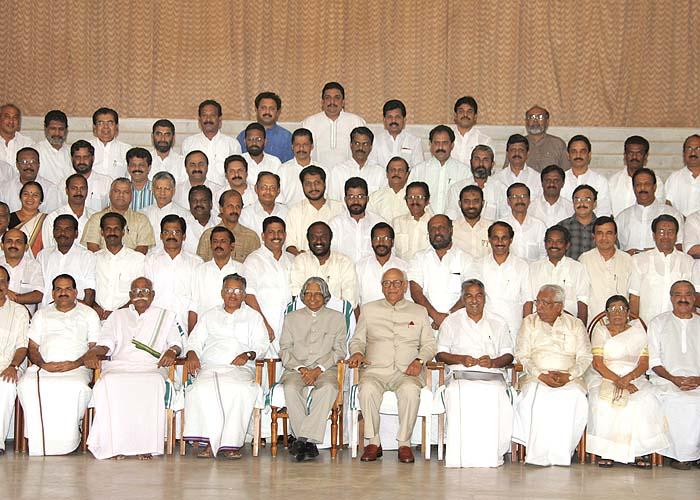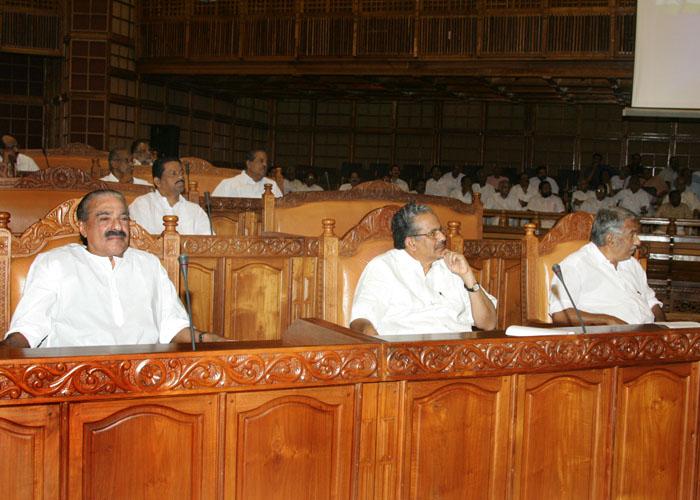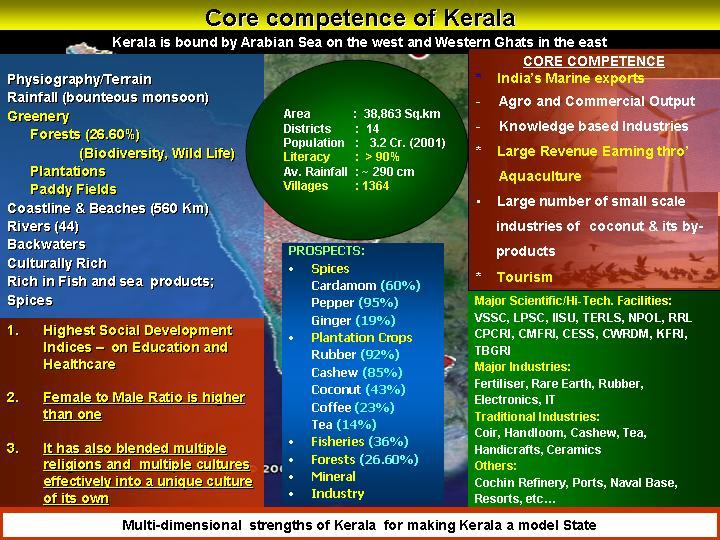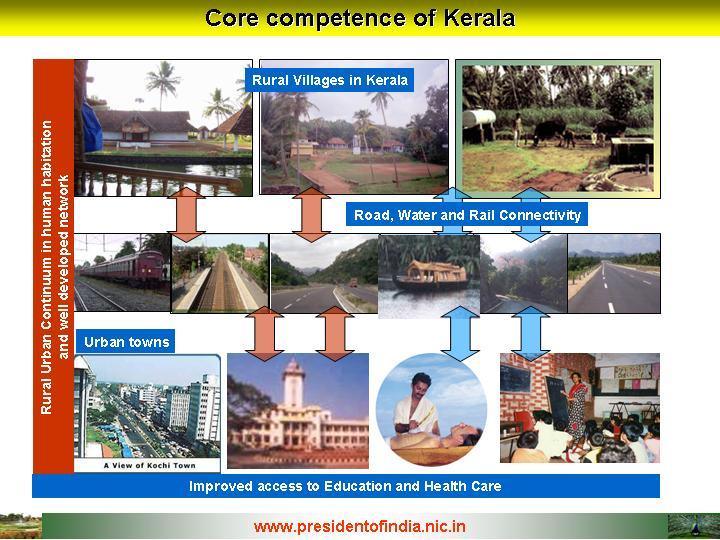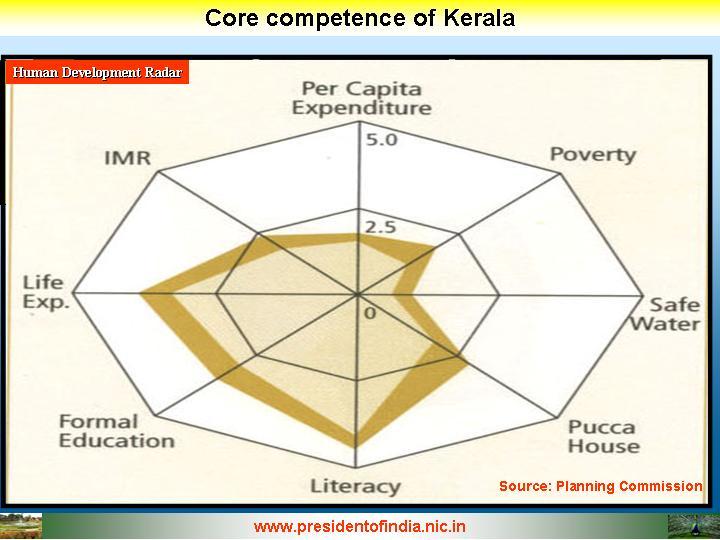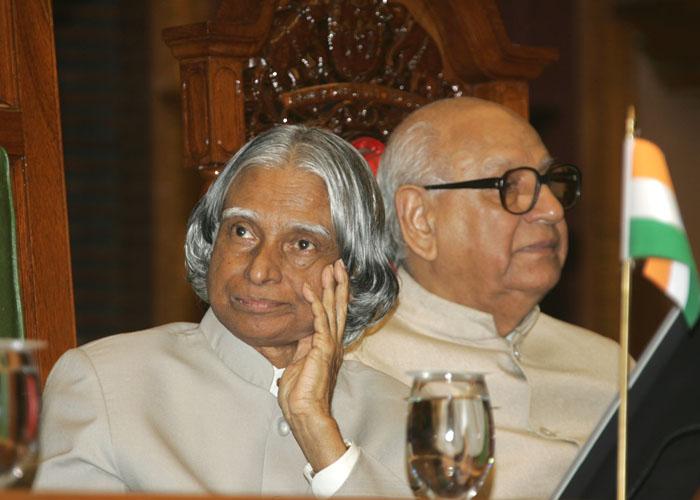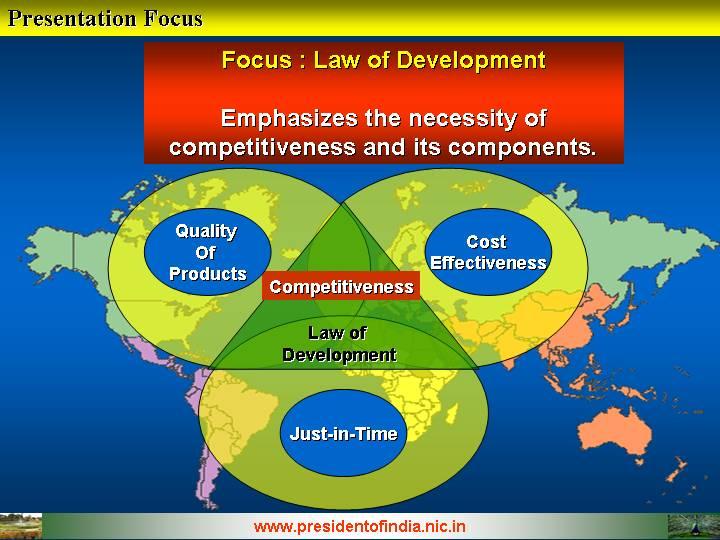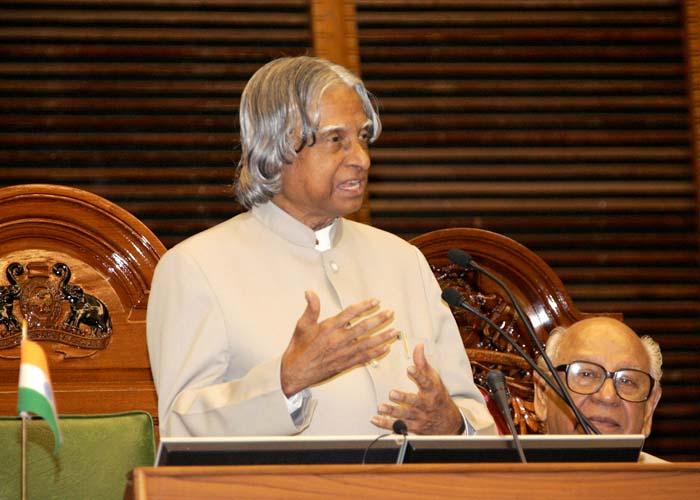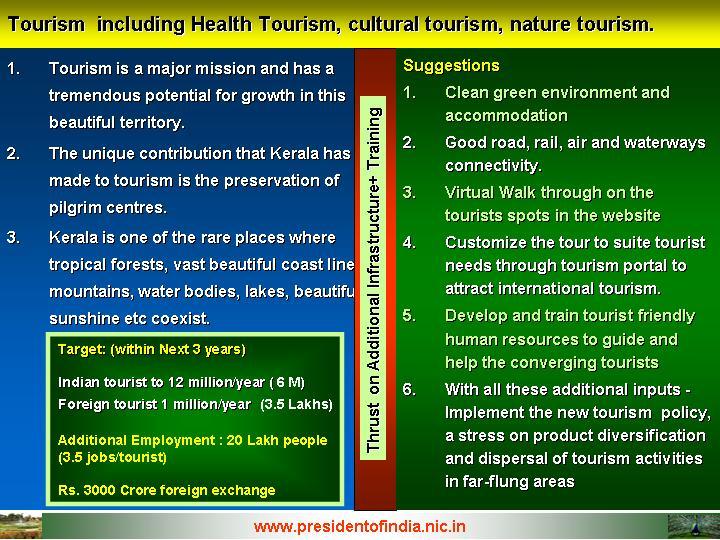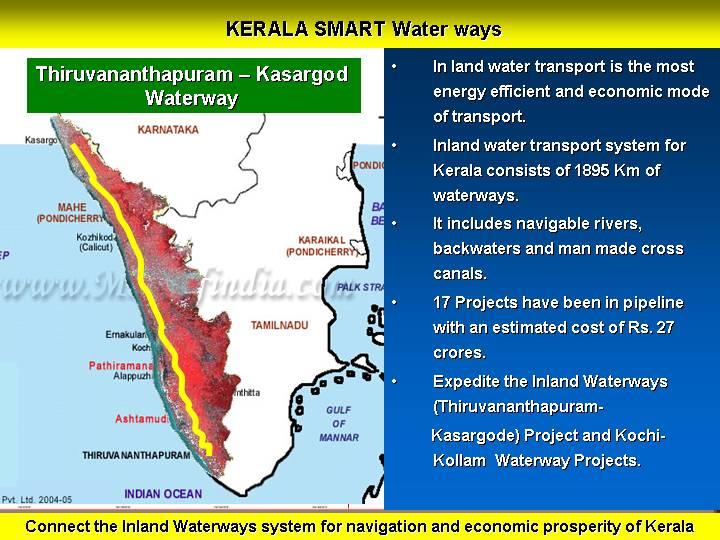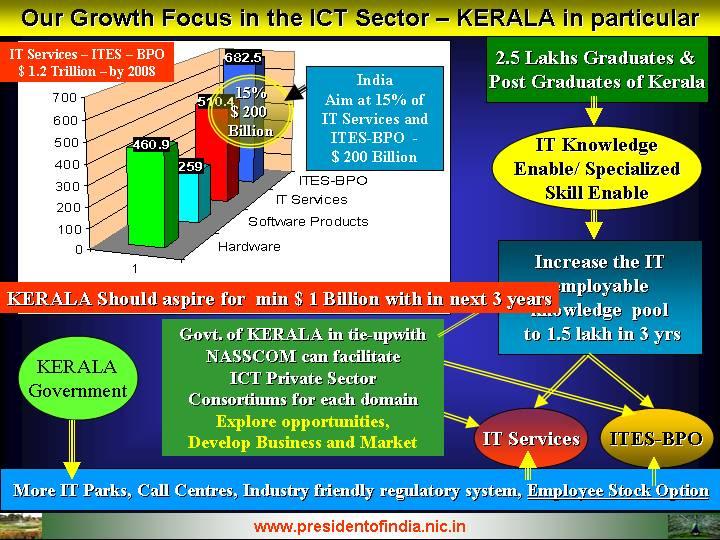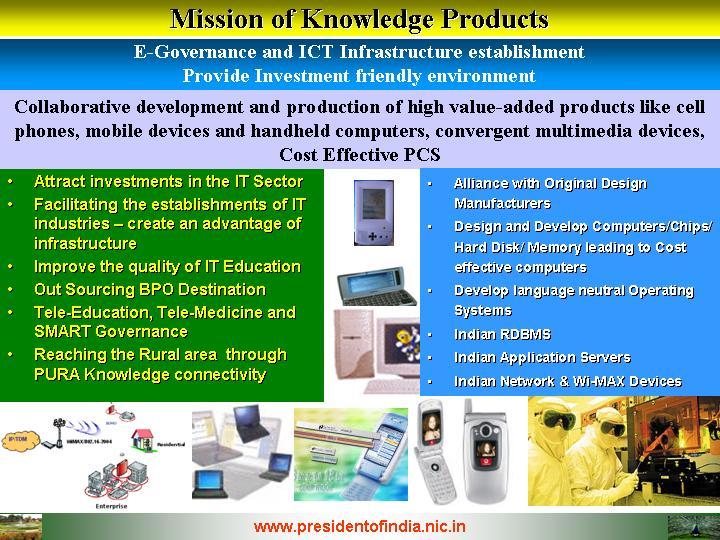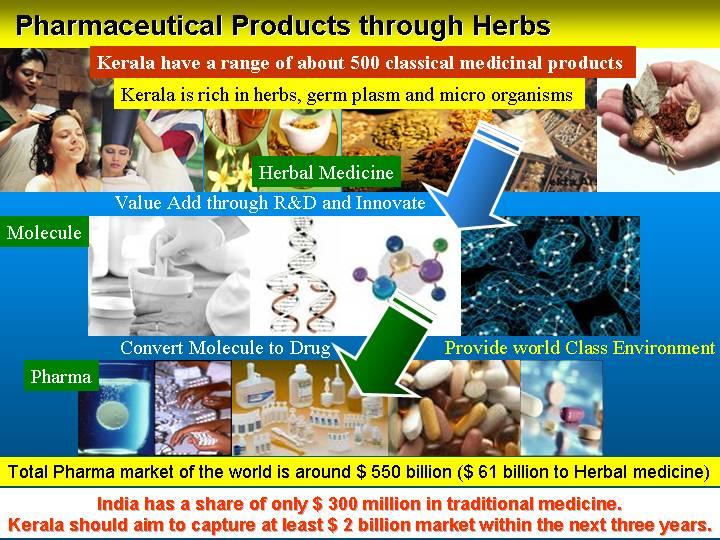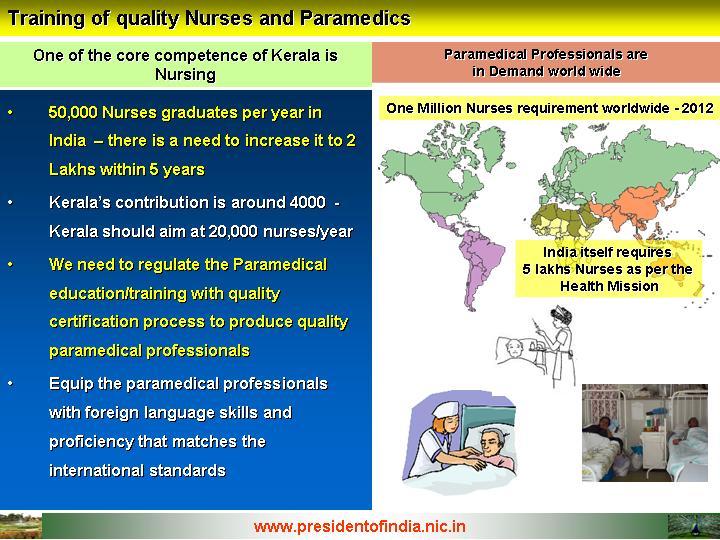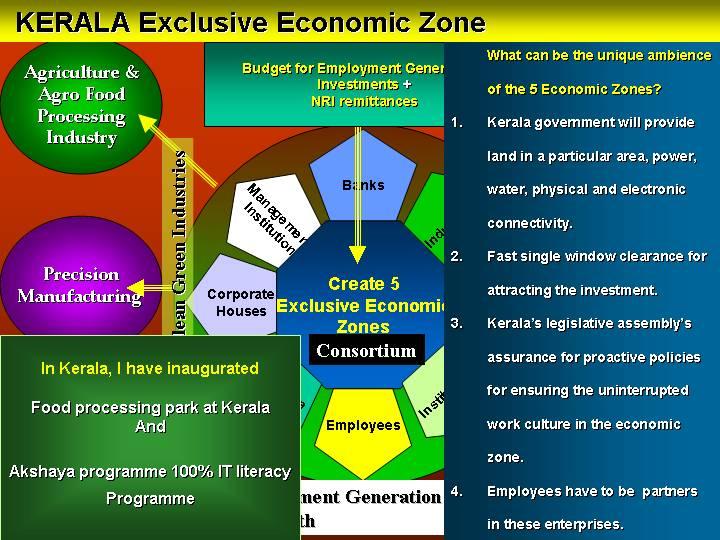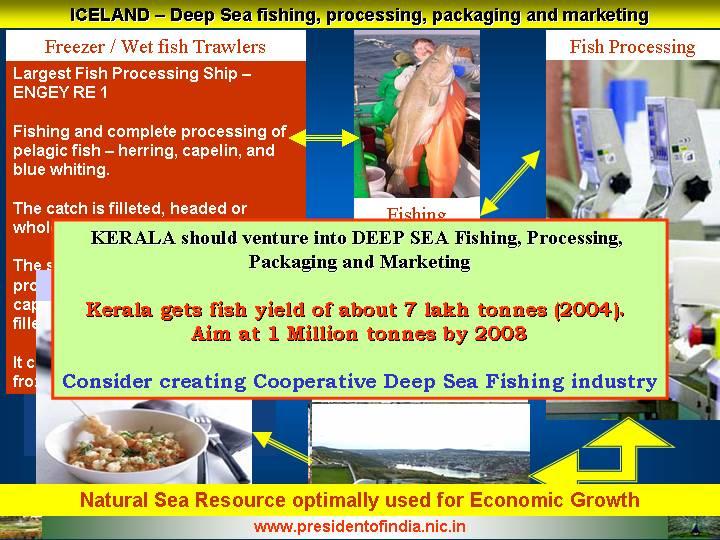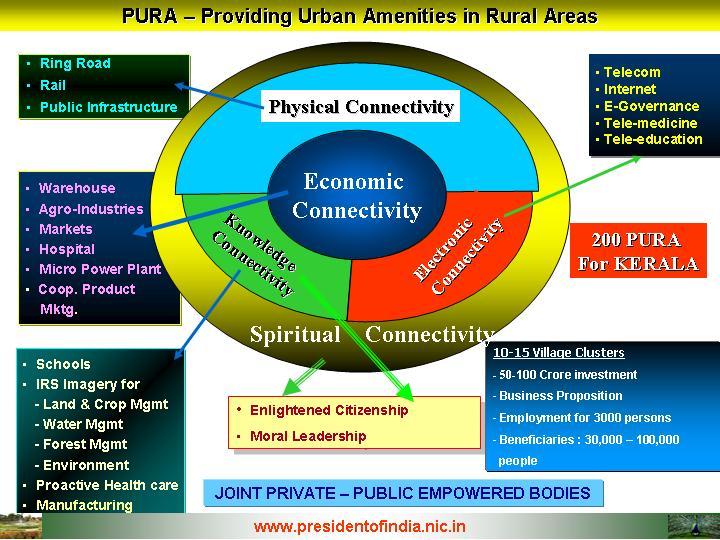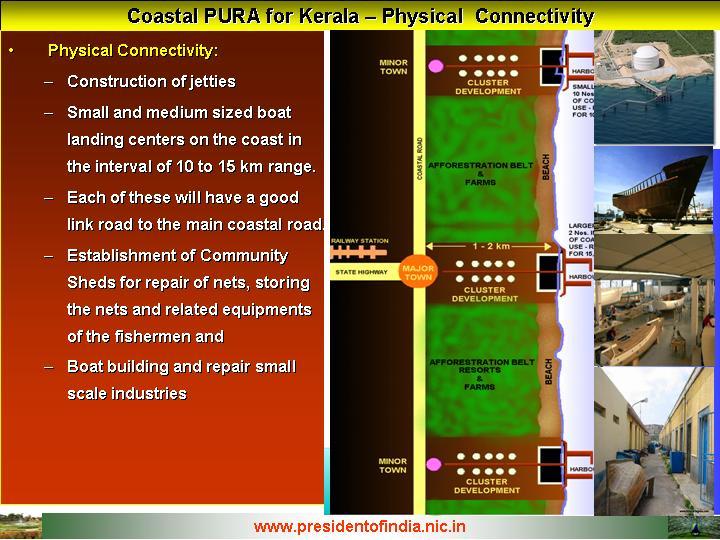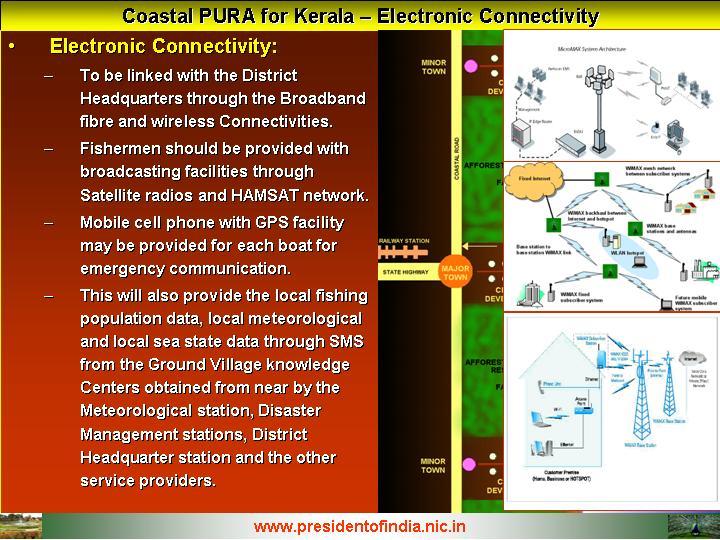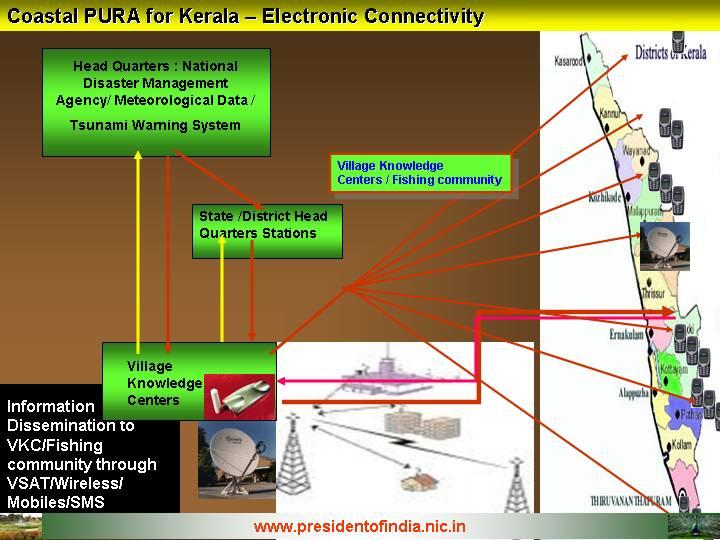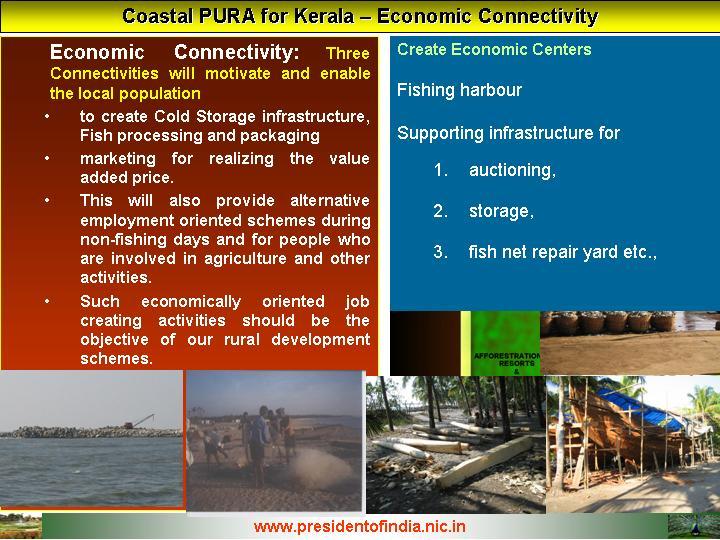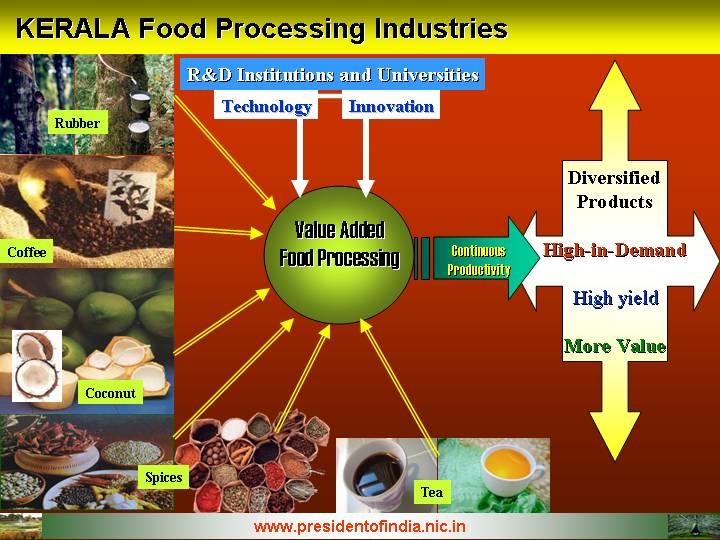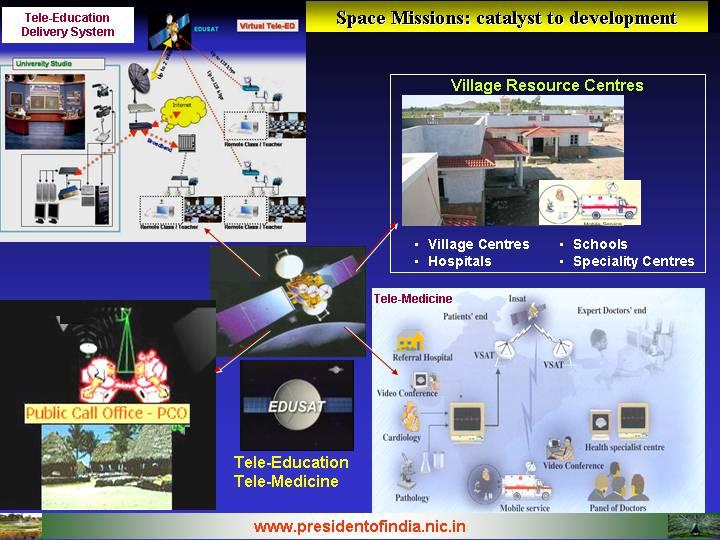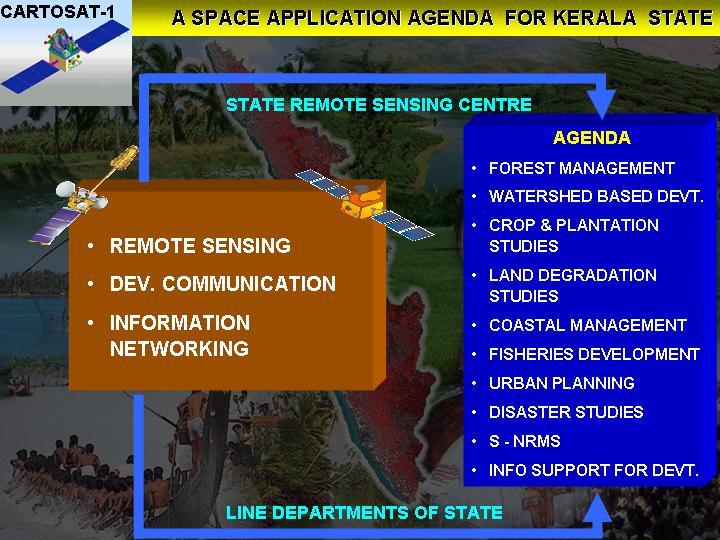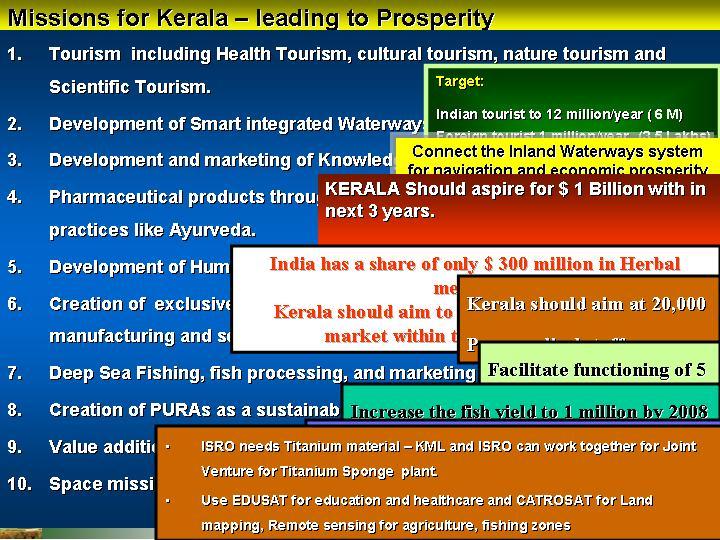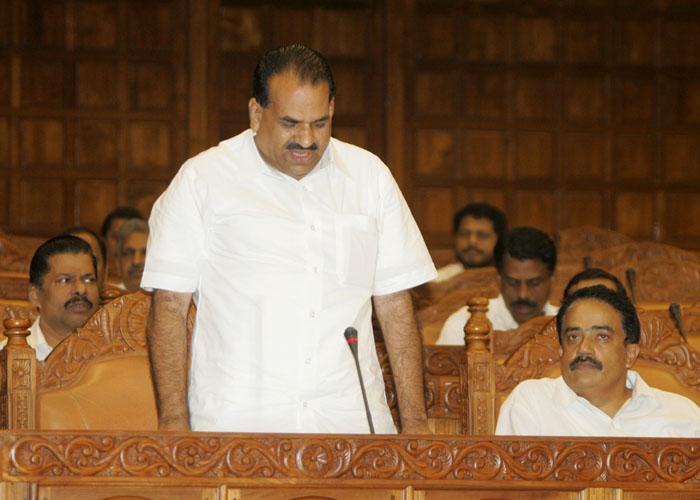Address to the Members of the Kerala Legislative Assembly, Thiruvananthapuram
Thiruvananthapuram : 28-07-2005
Missions for Kerala's Prosperity
I am delighted to be in this beautiful environment of Thiruvananthapuram and also to get this opportunity to address the Hon?ble Members of the Legislative Assembly of Kerala. I am very happy to be here in the Kerala Legislative Assembly which is an institution that gives vision to the state, evolves the legal frame-work for the policies and programmes of the state and gives shape to the aspirations of the people of this state, 75% of whom live in rural areas.
The political history and economic growth of Kerala are seen to be rhythmic and closely interwoven with that of our nation as a whole. Legislative Assembly of Kerala has witnessed and wisely guided several important phases of the State?s growth since its formation in the year 1956. In the face of many challenges, various governments have placed Kerala on a positive-growth track. I would like to discuss with the Hon?ble Members of Kerala Legislative Assembly: "Missions for Kerala?s Prosperity".
Kerala's prosperity is India's prosperity
Twenty years of my stay in Kerala gave me many good friends. I have traveled throughout the state; I understand the people of Kerala, their way of life and problems. When I travel abroad, I make it a point to meet people of our country settled in those countries. One important information that, I would like to convey to all of you is that people of Kerala wherever they are, they want to see their state grow and prosper. They want to come to Kerala often to remain attached to their roots. Heads of various Countries have lots of praise and they acknowledge the contribution made by Indians particularly people from Kerala. Kerala?s prosperity is India?s prosperity.
Unity of Minds
When I am here, I would like to recall an incident which happened four decades ago. Dr Homi Bhabha and Prof Vikram Sarabhai were looking for a site to establish space research station in the equatorial region. These two great scientists visited a number of places. Thumba in Kerala was selected by the scientific community for space research as it was near the magnetic equator within the flow of electrojet and was ideally suited for ionospheric research in upper atmosphere, apart from study of atmospheric structure. When Prof Vikram Sarabhai visited Thumba, the locality had many villages and thousands of fishing community were living in that area. It also had an ancient St Mary Magdalene Church at Pallithura and a Bishop's House. Prof Vikram Sarabhai met many politicians and bureaucrats to get the place to set up an establishment for space science research work. He could not succeed because of the nature of the place. He was asked to see the Bishop of Thiruvananthapuram. At that time, Rev Father Peter Bernard Pereira was the Bishop. It was a Saturday when Prof Vikram Sarabhai met the Bishop. The Bishop smiled and asked him to meet him the next day. In the Sunday morning Service, the Bishop told the congregation, "My children, I have a famous scientist with me who wants our church and the place I live for the work of space science research. Dear children, science seek truth that enriches human life. The higher level of religion is spirituality. The spiritual preachers seek the help of the Almighty to bring peace to human minds. In short, what Vikram is doing and what I am doing are the same - both science and spirituality seek the Almighty?s blessings for human prosperity in mind and body. Children, can we give them God?s abode for a scientific mission?? There was a silence for a while followed by a hearty 'Amen?'from the congregation which made the whole church reverberate.
Subsequently, the big event took place in 1962. Rev Father Peter Bernard Pereira, the Bishop of Thiruvananthapuram, took the noble decision to dedicate the church in recognition of the national goal for the establishment of the Indian Space Research Organisation at Pallithura, Thumba. We made that church as our design centre, started rocket assembly; design of filament winding machine for FRP product and the Bishop's house was our scientists' place. Later, the Thumba Equatorial Rocket Launching Station (TERLS) led to the establishment of Vikram Sarabhai Space Centre (VSSC) and multiple space centres throughout the country.
When I think of that event, I can see how enlightened spiritual and scientific leaders, all converge towards giving reverence to the meaning of human life. New church and new schools were established in record time. Of course the birth of TERLS and then VSSC gave the country the capability to design, develop and produce huge world class rocket system and subsequently, India built the capability of launching geo-synchronous, sun-synchronous and meteorology spacecraft, communication satellite, remote sensing satellite thereby provided fast communication, weather forecasting and also the ability to locate water resources for the country. Today, neither Prof Vikram Sarabhai nor Rev Father Peter Bernard Pereira are with us but the fragrance of their nobility is still with us. Bhagwat Gita says: "See the flower, how generously it distributes perfume and honey. It gives to all, gives freely its love. When its work is done, it falls away quietly. Try to be like the flower, unassuming despite all its qualities". This beautiful incident happened in the soil of Kerala. What a great message it gives to every generation of this nation. Unity of Minds is an important feature of the people of Kerala. This core competence of Unity of Minds is one of the greatest assets for the development of the State.
In addition, historically, Kerala has been crucible of multiple religions and multiple cultures. It has also blended these effectively into a unique culture of its own. We have to collectively see how these multi-dimensional strengths of Kerala, its secular ethos, bounty of natural resources and excellent human resource can be used for making Kerala a model State for rest of the country to follow.
When I am with you, I would like to congratulate the people of Kerala for their unique achievements in two areas :
(i) Unity of Minds among the people and
(ii) Kerala leading the nation as number one in the National Human Development Index. I consider these two characteristics as an essential base for transforming Kerala into an economically developed state, which will assist India as a whole to become a developed nation. It is in the hands of Hon?ble Members of Legislative Assembly of Kerala, to make use of these two unique characteristics to transform Kerala into a developed State. Let us study the core competencies of Kerala that can be used for development of the state.
Core competence of Kerala
Kerala is bound by Arabian Sea on the west and Western Ghats in the east. It has bounteous monsoon, 44 rain fed rivers, large biodiversity, vast coast line, ancient culture and friendly people. Kerala, having a moderate climate throughout the year, is also a home to many a rare species of birds, flora and fauna. With this climate and locale Kerala is rich in fish and sea products, rubber, spices, tea, coffee, herbs, fruits, and coconut and water resources.
Massive investment in health and education combined with good administration, private and civil society participation helped in enriching human resource development in Kerala. Effective management of Government family planning programme and contribution of private doctors have played a significant role in reducing mortality and fertility rate. The wide spread coverage of print and electronic media along with cinema in the state helped improve communication for the spread of family planning concerns. A rural urban continuum in human habitation and well developed transportation network - by road and water - improved accessibility to health services and education. Migration of Keralites, apart from easing the population pressure and unemployment has brought in considerable monitory remittances to families in Kerala which have improved the living standard. (Ref: National Human Development Report 2001).
With all these favourable factors, what can be the missions for Kerala? There cannot be any other mission, other than removing the poverty of the people and bringing prosperity to the State in a time bound manner. At this stage, let me share with you a Development Radar brought out by the Planning Commission for various states. Dear Members, while the whole nation appreciates you for your Human Development Index and Unity of Minds, you may closely study with me about the development radar. The boundary of octagon indicates the maximum achievements of various indicators of development. The smaller octagon represents the national average. While we appreciate you for your achievements in literacy, life expectancy, pucca house and to some extent formal education. It is essential to the Hon?ble Members must realize that Kerala has got potential to remove the poverty altogether and also give impetus to growth potential of this society, so that by 2010 Kerala can become a developed state with economic growth and prosperity in life.
Focus Kerala
My presentation to this Legislative Assembly will focus on how the percapita income of Kerala can be increased from the existing Rs. 23,000 to Rs. 50,000 (at 2004-2005) in three years time and also to create investment friendly climate leading to employment avenues for the 3.7 million educated unemployed particularly the three lakh graduates and post-graduates of the State and several others who do not have such qualifications. This will help in removing the poverty of 4.1 million people competitive for investment, efficiency, productivity and quality. Now I would like to discuss with the Members, the Law of Development that defines the competitiveness.
Law of Development
I was studying the development patterns and the connectivity between nations, especially in trade and business. As you all know the world has a few developed countries and many developing countries. What is the relationship between them and what connects them? Developed countries have to market their products in a competitive way to different countries to remain as developed nations. The developing country too have to market their products get transformed into developed country; they too have to market their products to other countries in a competitive manner to get transformed into a developed country. Competitiveness is the common factor between the two types of countries, both developing and developed. It has three dimensions: quality of the product, cost effectiveness and timely supply. Indeed this dynamics of competitiveness in marketing of products by developing and developed countries is called the law of development. Hence, competitiveness must be the focus for every activity. It can be seen that the state has to produce products and market within the state and other states in India and also in other countries. What products can be made for the country and others competitively? Keeping this in mind, I would like to suggest the following missions for sustainable development of Kerala.
Missions for Kerala
Let us study what are the missions which Kerala can undertake using the core competence of the state.
The following are the missions for Kerala?s Prosperity by the year 2015.
1. Tourism including General, Spiritual, Health, Science
2. Development of smart waterways.
3. Development and marketing of Knowledge Products
4. Pharmaceutical products through herbs (molecule to Drug) as well as Ayurveda.
5. Quality training to Nurses and other paramedics.
6. Creation of exclusive economic Zone to attract NRI and other investors.
7. Deep Sea Fishing, fish processing, and marketing of sea food products
8. Establishment of PURAs at the coastal regions to bring prosperity equally to the Urban and Rural population.
9. Value addition to tea, coffee, spices, coconut and fruits
10. Space technology is well established in Kerala. This has to be used for connectivity of Kerala and also enriching the small scale industries, skill training. Starting Joint-Venture between Kerala government industries and ISRO.
Let me now discuss the each missions individually.
Tourism including General, Spiritual, Health, Science
Tourism is a major mission and has a tremendous potential of growth in this beautiful territory. Kerala has many tourism and pilgrim centres such as Sabarimala, Guruvayoor, Bolghatty Palace, Kumarakom Lake resort near Kottayam, beaches like Kovalam, hill stations like Munnar, and Wildlife sanctuaries like Eravikulam and Periyar, architectural and civilizational heritage. Kerala is one of the rare places where tropical forests, vast beautiful coast lines, mountains, water bodies, lakes, beautiful sunshine etc coexist. It is nature?s special manifestation. In addition to this it is endowed with number of scientific and R & D organisations of interest to scientific tourists.
Infrastructure Development: When the tourists visit any country, they like to realize maximum value for their stay which can come only through reliable and fast travel facilities to all tourist destinations. Creation of these facilities will involve infrastructural development such as airports, railway line, multi lane roads and inland waterways to interior India.
Another important infrastructural need is quality clean accommodation, which can be realized through public-private sector participation. They should plan adequate number of hotel rooms with various amenities including good environment and communication facilities. Quality hospitals with state-of-the art super speciality facilities should also be built urgently to increase health tourism.
Human Resource Development: We need people friendly professional tour operators having proficiency in this field. They should have the ability to use modern tools and be able to provide in-depth factual data about various places of interests to the tourists. They should also guide them to avail diversified tourist products such as general, spiritual, health and science tourism.
The website of Kerala Government gives some basic information about hotels and possible routes etc, but it still does not exploit the visual power of the web to depict the natural beauty and cultural complexities of Kerala. The website should aim at taking the tourists on Virtual Tour and provide customized tour based on the interest of the tourists.
Wealth Generation: Kerala with its unique ?tourist selling propositions? can definitely increase the tourist arrival to 12 million from the existing six million internal tourists and to one million international tourists from the existing 3.5 lakhs. This increase in international tourist arrival alone will provide additional employment to approximately twenty lakh people in various sectors of the tourism industry as per international norm of 3.5 jobs for one tourist. It will also generate business of over Rs. 3000 crore in foreign exchange. Similarly health tourism will generate additional employment for medical personal. While promoting tourism we should ensure that ecology is not disturbed and the natural environment is fully protected as in Sikkim.
Development of smart waterways
The inland water transport system of Kerala has navigable rivers, backwaters and man made cross canals. What Kerala needs, as visualized, is a major water way extending from Thiruvananthapuram to Kasargod. This will connect the whole state with all other cross canals. In addition, for making effective use of the total waterway potential existing canals and river water systems are required to be improved to make it into smart waterway systems. A smart waterway will have the characteristics such as: sufficient navigable depth and width; conditions will permit navigation throughout the year; have smooth bends and minimum siltation; be able to navigate at least 18 hours per day; cater for efficient loading and unloading points; and the waterway should be adequately lighted and equipped with modern navigational and communication aids. Presently the waterway navigation is used between Vembanad lake to Thrissur. The development of west coast canal from Kottappuram to Kollam and Udyogmandal to Champakara Canal as National Waterway No.3 is in progress. The other areas have to be taken on priority to establish cost-effective transportation system for the industry and backwater tourism in State. This facility will enable the State to take advantage of the energy efficiency of transportation through waterways which is double of railways and eight times the road transportation system for a given load. This will also reduce the congestion on the road, and improve the environmental conditions and aforestation. Hence, there is a need to embark on a mission mode programme to make the total waterways length operational by improving the maintenance, dredging and creating water transport facilities through public - private partnership. This has to be a joint effort between the State and Central Government. Also, wherever the land acquisition and resettlement problems are coming in the way a special dispensation needs to be found for removing the bottlenecks.
I have seen waterways in many countries leading to the progress of the economy and tourist attraction. The Government must undertake to provide policy and legal support for the private operators to function without bottlenecks. Development of smart waterways to the length of 650 kms will require detailed planning taking into account of additional irrigation potential, drinking water to population, flood control, additional power generation, tourist traffic potential and employment potential. The detailed project report has to be prepared and Govt. has to entrust the task to professional bodies.
Kerala legislative assembly may consider generating a policy of Smart waterways for power generation, tourist transportation, and material transportation round the year. I am sure technological upgradation of Kerala Waterways with progressive policy will lead to prosperity of the state through employment generation.
Development and marketing of Knowledge Products
As you all know, information and communication technology is the core competence of the country. The IT revenue for the nation during the year 2004-05 was $28 billion, out of which export accounted for $18 billion. The contribution from Kerala has been very low in the ICT sector till now. Kerala should venture into the development of knowledge products in addition to other IT enabled services.
Knowledge products come out of innovation to the Information Technology. Kerala is endowed with human resource required for IT tasks. Also, Kerala has infrastructural facilities which are affordable and the State is connected to countries abroad through two international airports. It is essential to have an improved public transport system in the cities and the development of social infrastructure. The most important ingredient for knowledge products production is the clean environment, skilled manpower and above all a competitive environment to perform without interruptions. Kerala should aim at in developing, producing and marketing knowledge products in a big way through a consortium approach between the committed academic institutions, local IT industries and Govt. Agencies and employees should be the partner. This has to be the minimum condition. A task team can be formed by the State Government with experts drawn from different IT areas for formulating and implementing a plan to develop, produce and market at least $2 billion worth of IT products and IT enabled services including BPOs by 2008 in the domestic and international market. This will generate employment for at least one lakh graduates and post-graduates of this State, apart from the school educated. Kerala has to generate entrepreneurs particularly for running small enterprises.
Pharmaceutical products through herbs (molecule to Drug) as well as Ayurveda
Knowledge of ancient medicine is an unique resource of India. It has the treasure of a minimum of 5000 years of civilization. I am also delighted to note that many institutions have opened a number of Centers across Kerala and have a range of about 500 classical medicinal products which are manufactured according to the traditional Ayurvedic prescriptions under the supervision of qualified and quality-driven Ayurvedic physicians. This contribution of providing effective remedies for various kinds of ailments such as chronic arthritis, paralysis, ulcers, discogenic diseases, degenerative diseases of central nervous system, neuro- muscular disorders. Allergic diseases, eye diseases, psoriasis, psychiatric ailments, geriatric ailments etc., are indeed noteworthy and have achieved international recognition, which is evident from the fact that large number of foreign patients come to India for treatment. These medicines are being sold through authorized distributors in countries like UAE, Kuwait, Bahrain, Singapore and Malaysia. Ayurvedic products have not yet captured the large Pharma market in the western world. It is essential, just like modern medicine (allopathic) from molecule to drug development; it goes through the cycles of laboratory evaluation, stages of ethical clearance, animal test, multi-centric test and human test. In Kerala it can initiate action with good Pharma companies jointly working with Ayurveda institutions ? both will benefit. We must also incorporate necessary measures for protecting the Intellectual Property Rights of the innovator.
Kerala is rich in herbs, germ plasm and micro organisms. Industrially developed countries are importing these bio-resources in the raw forms and adding value to them for export to developing countries including India as special seeds, medicines and bio-materials, fully protecting patents of these products. Instead of allowing export of such resources and importing value added products at high cost, we must add our own technology through R & D efforts for conversion of such resources to value added products for domestic requirements and also for export. As you are aware, today the total drug market of the world is around $ 550 billion of which $ 61 billion pertains to Herbal drugs. India has a share of about 300 million dollar of traditional medicine. Kerala has the potential to enter into a big way in the traditional medicine markets and increase the business to two billion dollars with in the next 3 years. This has to be done in a mission mode by creating investment friendly environment, standardisation of drugs, improvement of quality of drugs, good agricultural and collection practices and promotion of Indian brand name.
Quality Training to Nurses and other Para-medics
Nursing is a core competence of Kerala. India is in the process of improving the healthcare services which will need additional 5 lakh nurses. As per the latest report, worldwide requirement for nurses are estimated to be around one million from now to 2012. Presently, in India about 50,000 nurses qualifies every year. There is a need to increase this capacity to 2 lakhs within the next five years in the country. The present contribution of 4,000 Nurses from Kerala State should also increase at least 20,000 Nurses per year. In addition there must be a special drive to equip the nurses with training at various healthcare centers and super speciality environments and equip them with language skills and proficiencies that can match the required international standards. Kerala can definitely cater to at least 50% of the total demand i.e. provision of one million nurses from now to the year 2012. The Department of Health in Kerala should draw up a scheme and embark on an intensive nursing training scheme in collaboration with the Central Government which will enable generation of quality health care professionals at the rate of 2 lakh nurses per year. In addition, with increasing complexity of healthcare profession with diagnostic equipment, tele-medicine, clinical trials etc. There is a need for many other specialized paramedical personnel. Skilled technicians and the para medical assistance are in great demand world over in the healthcare sector. The Tremendous potential exists for educated youth to take up nursing and para-medics as a profession. The generation of quality nurses can be taken as one of missions for the development of healthcare services in Kerala without sacrificing quality.
Also, a large number of medical doctors and nurses will be required for rural complexes in the State when PURA is in position.
Creation of an Exclusive Economic Zone
Both Central and State budget normally will have a core task of GDP growth of the state and also the employment generation. This core task will fructify only investing the budgeted fund in agriculture and food processing, investment in industries including small scale industries and service sector particularly the production of knowledge products. Also there is a unique environment in Kerala there is a foreign remittance to the tune of Rs. 18000 Cr. Most of it will be deposited in the bank or used for constructing buildings. A method has to be found, how the development in all the three sectors of the economy can be evolved within the Kerala environment. That is the beautiful natural environment, the beautiful industrial environment has to be created. It is in the hands of this legislative assembly. How it can be done? I have given few thoughts. Let me share with you. I suggest the Kerala legislative assembly to consider forming 5 Exclusive Economic Zones in the state depending upon the core competence of the districts in the three sectors particularly in knowledge products production in IT and BT, precision manufacturing and agro food processing industries.
What can be the unique ambience of the 5 Economic Zones.
a. Kerala government will provide land in a particular area, power, water, physical and electronic connectivity.
b. Fast single window clearance for attracting the investment.
c. Kerala?s legislative assembly?s assurance for proactive policies for ensuring the uninterrupted work culture in the economic zone.
d. Employees have to be partners in these enterprises.
I myself participated in inaugurating food processing park and also transforming a 100% IT literacy through Akshaya programme.
Deep Sea Fishing, fish processing, and marketing of sea food products
As you all are aware, I belong to Rameshwaram Island, where fishing is an important occupation. Recently I visited Andaman & Nicobar Islands. Even though it has tremendous potential in fishing, it has not been taken up as a fishing industry. In India, we have still not gone for deep sea fishing. When I was in Iceland in June 2005, I studied their economy, their highest per capita comes from fishing industry. Hence I took interest to study the fishing industry in Iceland. Eventhough they have a vast sea all around their territory, they have ?sea area silence? that means particular period no fishing boats are allowed to catch fish. This allows sufficient grownup fish catch for the fishermen during rest of the period. Also the sea zones are allotted to the fishermen based on the satellite fish school data. They have satellite surveillance and land communication to safeguard their economic zones, so that other countries do not enter for fishing. But most important thing, I would like to convey is their success in deep sea fishing. I visited one of the very big fish trawlers which has 200 tons fish processing capacity and 1800 tons storage capacity. The deep sea fishing, fish processing, packaging and marketing ? all these aspects are taking place in the middle of the sea. It gives a new dimension to the whole fish industry. Probably Kerala Government can consider a co-operative society for the fishing community with the economic and managerial assistance so that per capita income of our fishing community will substantially increase. At present, Kerala gets fish yield of about 7 lakh tonnes (2004). I understand ISRO is helping through satellite imagery of the fish population in certain zones. We believe Kerala can increase the fishing yield to one million tons by 2008 by helping fishermen folk with proper communication facilities for the safe return, satellite imagery at right time, boat and fishing net repair facilities.
Establishment of PURAs at the coastal regions to bring prosperity equally to the Urban and Rural population
I have studied about Kerala?s terrain and the number of districts, towns and villages. Kerala and its regions require a unique Coastal PURA (Provision Urban Amenities in Rural Areas) due to the existence of 580 km long coastline. I would recommend establishment of 200 PURA units for Kerala. This will provide four critical connectivities between villages located in different geographic locations enabling accelerated economic growth: physical, electronic and knowledge connectivity, leading to economic connectivity. Let us study that connectivities.
Essential Connectivities These are: physical connectivity of village clusters through quality roads and transport so that all the villages will be connected by the road and in turn into the high ways. Kerala is having physical connectivity in many of its villages. Electronic connectivity through tele-communication with satellite, high bandwidth fiber optic cables, wireless reaching the rural areas from cities and through internet kiosks. This will enable the urban facilities like super speciality hospitals, educational institutions to provide value added services to rural areas. Knowledge connectivity provides education, skills training for farmers, artisans and craftsmen and entrepreneurship programmes. These three connectives will lead to Economic connectivity so that employment potential will increase through starting of small scale industries, food processing industries coming in a big way with the help of banks, micro credits. Since western part of the Kerala is facing the sea I would like to discuss some of the special characteristics of coastal PURA.
Coastal PURA: I have discussed with Dr. P.S. Rana, Chairman HUDCO on the development of coastal PURA for the affected areas of Kerala. He had made a detailed study on the development of Coastal PURA for the tsunami affected KERALA coastal region. I would like to share with you the design of the coastal PURA.
Physical Connectivity: Construction of jetties and small and medium sized boat landing centres on the coast in the interval of 10 to 15 km range. Each of these will have a good link road to the main coastal road. Some times road transportation may be complemented with waterways. Establishment of Community Sheds for repair of nets, storing the nets and related equipments of the fishing community and Boat building and repair small scale industries.
Electronic Connectivity: All the fishing villages on the coastal areas have to be linked with the District Headquarters through the Broadband fibre and wireless connectivities. Fishing community should be provided with broadcasting facilities through Satellite radios and HAMSAT network. Mobile cell phone with GPS facility may be provided for each boat for emergency communication. This will also provide the local fishing population data, local meteorological and local sea state data through SMS from the Village knowledge Centres obtained from near by the Meteorological station, Disaster Management stations, District Headquarter station and the other service providers.
Knowledge Connectivity: Government should facilitate the training of fishing community in cost effective safe fishing techniques, application of technology for improving the productivity, storage and preservation systems and cost effective marketing, banking & financing systems through the District Headquarters Studio and the connected village knowledge centers. It will also provide adequate warning data for the fishing community on the sea to return to home safely.
Economic Connectivity: These three connectivities -physical, electronic and knowledge will motivate and enable the local population to create economic centres such as Cold Storage infrastructure, Fish processing and packaging and marketing for realizing the value added price. This will also provide alternative employment oriented schemes during non-fishing days and for people who are involved in agriculture and other activities. Such economically oriented job creating activities should be the objective of our rural development schemes.
Value addition to Rubber, Tea, Coffee, Spices, Coconut and fruits
Kerala has been traditionally producing rubber, tea, coffee, spices, coconut and fruits for several years. But over the years many other countries are also producing these commodities and intense competition is being faced by the growers. There is a need to inject technology and innovation to have continuous growth in productivity. Also there is a need to find value added diversified products from the various produce suiting the needs of the customers. For example the average yield of rubber is around 1700 kg per hectare. In the competitive environment this yield will provide just around one lakh rupees to the grower. R&D institutions located in Kerala such as Rubber Research Institute in partnership with other global sources and rubber growers and rubber users should develop new varieties of rubber which can provide double the yield in a prescribed time frame. Also the research institutions can suggest certain types of shade tolerant crops which can grow in the rubber gardens leading to generation of additional revenue to the farmers. Bee keeping is another area which can be done as part of the rubber growing activity. Similarly innovative uses of tea, coffee, coconut and value added fruits and its by-products should be developed by respective research institutions and the growers which will enable the farmers to face the international competition and generate higher level of wealth for the state.
Now I would like to discuss how the space missions of the nation can be used as a catalyst for the development of Kerala.
Space Missions catalyst to development
Apart from INSAT, IRS Satellite, you would have heard about the recent launching of CARTOSAT satellite ? a GeoMapper in the orbit, giving excellent stereographic images and also the educational satellite (EDUSAT) which has got a mission of connecting 1.5 lakh terminals. Recently, I inaugurated 6 Village Resource Centre (VRC) located in Kerala provided with Tele-education, tele-medicine, tele-agriculture facility by AMRITA University. The tele-medicine and tele-education connectivity has been provided by ISRO with other locations in Kerala.
The establishment of Vikram Sarabhai Space Centre is indeed a technological achievement, impacting the life pattern of Kerala and having tremendous potential to transform the lives of the people of Kerala, particularly by providing education, health care and international connectivity. The investment in space technology during the last four decades would be over Rs. 10,000 crore. Also, over seven thousand people are directly employed in VSSC and one lakh people will be contributing indirectly to the space programmes. I am discussing all these aspects with the Hon?ble Members of the Kerala Legislative Assembly to highlight how this high technology complex in Kerala can be effectively used for catalyzing the development of the State. I would suggest the establishment of following space technology driven missions for the benefit of Kerala in consultations with ISRO:-
a. As large number of Keralites live out side Kerala, they need education, they need health care consultations, they need tele-investment and tele-transfer of funds to their homes. An exclusive connectivity using satellite, fibre optics and wireless can be established between Kerala Government and ISRO to start tele-education programme to the Keralities living in the middle-east and elsewhere. This will enhance the employment potential, economic prosperity and also provide family connectivity.
b. ISRO has a plan to build large number of rocket systems, spacecraft systems ? there may be many accessories that can be built in small scale industries and definitely ISRO can technologically enrich the existing small scale industries and encourage setting up of new small and medium scale industries to support these programmes.
c. VSSC will need lot of electronic sub-systems and devise for ground segment and the rocket systems. They can participate in the establishment of IT/electronic parks for both hardware/software.
d. VSSC with its high-tech facilities can be requested to train five hundred skilled workers per year for deployment in various industrial complexes in the country and abroad.
e. ISRO can assist KERALA through the CARTOSAT-1 satellite by mapping all the Kerala River Sources and estimate the water resources and its management to connect the river sources for optimal utilization.
f. Titanium alloy is one of the preferred materials in the space and aircraft industry. Kerala has large deposits of Titanium Oxide. Kerala Minerals Limited (KMC) in collaboration with ISRO and other private sector joint venture partners can establish a plant for converting Titanium Oxide into Titanium Sponge. Incidentally, titanium is the metal of the 21st century as steel was in the earlier centuries.
Entrepreneurship
All these ten missions which I have discussed will require generation of large number of entrepreneurs in the State through entrepreneurship programmes. The academic institutions in Kerala generate about 2.5 lakh graduates per year and the 10th class and 10+2 students will be around 7 lakhs. All of them will seek employment either within Kerala, outside the state or abroad. Now the school syllabus and university syllabus have to be integrated with entrepreneurship courses. The students at the end of the course should get a certificate or a diploma. This will enable students qualified in these schools and colleges, to have the confidence that they can start the small enterprises in agriculture, manufacturing or services sectors. Banks have to be entrepreneur friendly and should give them venture capital and support these young entrepreneurs and their creative ideas. This system will change the situation in all the states, particularly in Kerala by generating employment providers rather than employment seekers.
Conclusion
In conclusion, I would like to share some thoughts with the Hon?ble Members of Kerala Legislative Assembly. Kerala has got the advantage of the development as it has the foundation and the combination of already established trend such as unity of minds and excellent performance in human development index. Kerala State is blessed with natural resources with large bio-diversity and above all, connectivity between the 27 lakhs people of Kerala living in different parts of the world.
Kerala will definitely become a prosperous, happy and safe state and become one of the India?s developed states with the execution of integrated ten missions which I have presented just now. In Thumba, Thiruvananthapuram I had an opportunity to be entrusted, in the year 1972, with the development of complex project SLV3, the first satellite launch vehicle system for placing the Rohini satellite in earth orbit by Prof. Satish Dhawan, the then Chairman, ISRO. I would like to recall to the Hon?ble Members what he had said after giving me the project ?if you do not have a mission, no problem will occur, but if you do have a mission or task definitely problems of varying magnitudes will crop up. But problems should not become the master of the individuals, individuals should become the master of the problem, defeat it and succeed?. So the Legislative Assembly which is responsible for transforming Kerala into a developed state, will definitely encounter some problems while executing many missions. But great leaders of Kerala will definitely defeat the problems and succeed. The problems will vanish, if the mission is taken as bigger than individuals or the organisations.
Dear Members, transforming Kerala into a developed State needs members of the Legislative Assembly to be Statesmen and you are.
My best wishes to all of you for success in these missions.
May God bless you.

